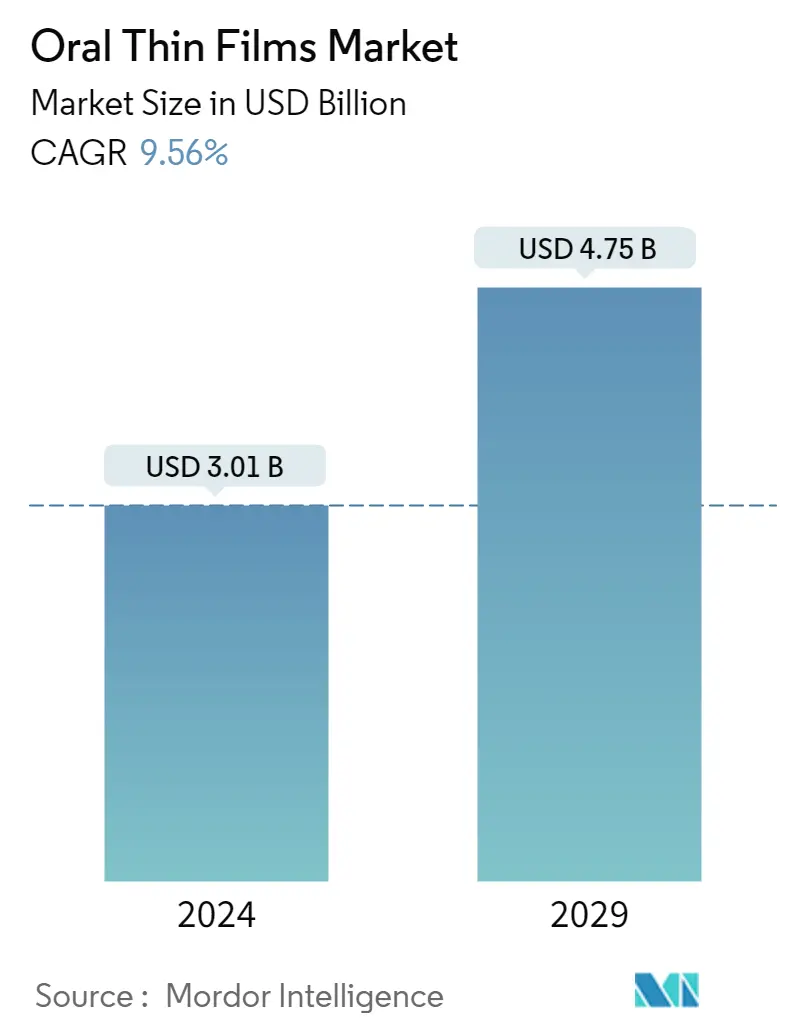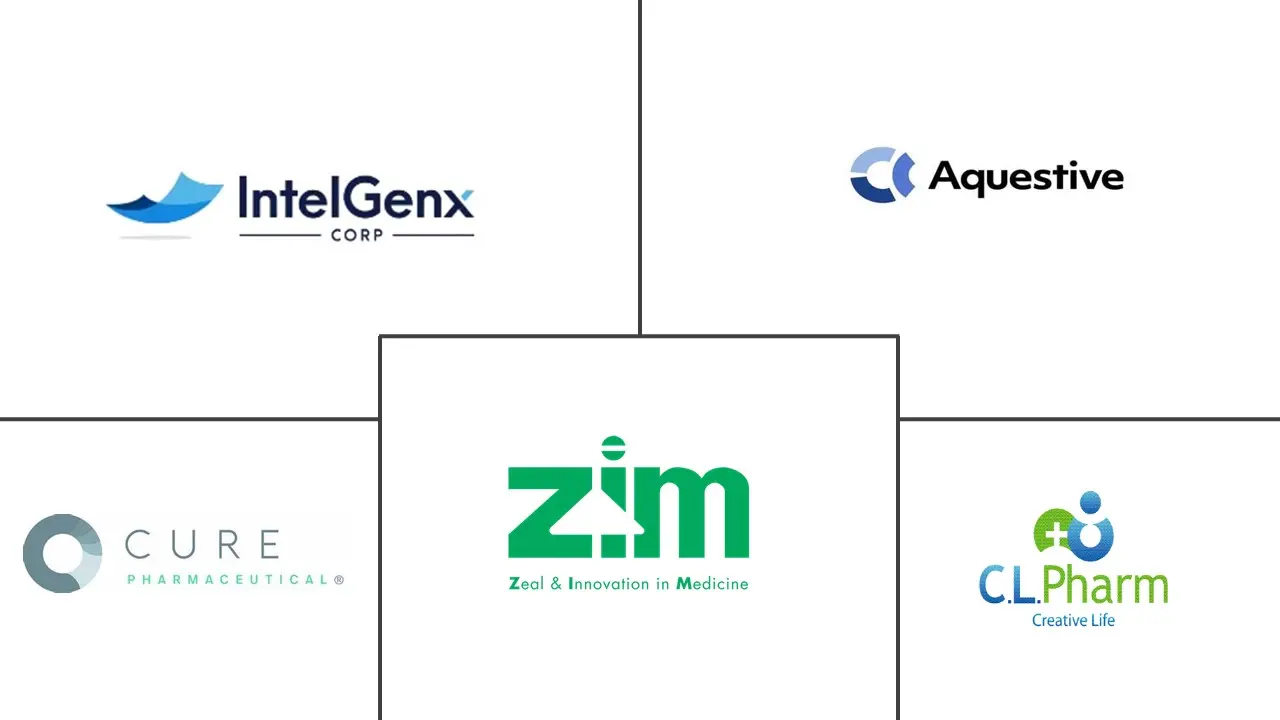Market Size of Oral Thin Films Industry

| Study Period | 2019 - 2029 |
| Market Size (2024) | USD 3.01 Billion |
| Market Size (2029) | USD 4.75 Billion |
| CAGR (2024 - 2029) | 9.56 % |
| Fastest Growing Market | Asia Pacific |
| Largest Market | North America |
Major Players
*Disclaimer: Major Players sorted in no particular order |
Oral Thin Films Market Analysis
The Oral Thin Films Market size is estimated at USD 3.01 billion in 2024, and is expected to reach USD 4.75 billion by 2029, growing at a CAGR of 9.56% during the forecast period (2024-2029).
The outbreak of COVID-19 impacted the market. People suffering from schizophrenia and migraine had a higher risk of mortality from COVID-19. For instance, as per the JAMA Psychiatry journal published in January 2021, adults with a schizophrenia spectrum disorder diagnosis were associated with an increased risk for mortality with COVID-19. Furthermore, according to the University of Manchester health data published in December 2021, people with psychotic disorders, such as schizophrenia, were five times more likely to die from COVID-19 and three times more likely to be hospitalized. The same report also stated that among people with COVID-19, those with psychotic or bipolar disorder had the highest rates of infection leading to hospitalization: 35.8% and 37.3%, respectively, compared to 16.6% among those without severe mental illness. Therefore, the demand for oral thins increased during the initial days of the pandemic as it is one of the effective treatments for such conditions. With the advent of the later strains of the virus the demand kept growing further, and it is likely to keep following that trend during the forecast period as well.
The growing burden of target diseases and the advantages associated with thin films are the primary drivers for the market. For instance, according to Parkinson's Foundation 2021, more than 10.0 million people were living with Parkinson's disease globally. The same report also stated that around 1.0 million were living with Parkinson's disease in the United States in 2021. Moreover, the risk of Parkinson's disease increases with age, and thus the increasing aging population around the world is also expected to positively impact the market. Furthermore, according to the 2021 Parkinson's Foundation report, it is expected that by 2030 there will be an increase of 1.2 million people suffering from Parkinson's disease. Oral thins are considered one of the effective treatments for Parkinson's disease. Therefore, the increasing prevalence of Parkinson's disease is anticipated to propel the demand for oral thins, thereby surging market growth.
Drug delivery via oral thin films offer several advantages which are also the major factors driving the market growth. The primary advantages of these films are dosage flexibility and ease of administration. They are also fast-acting and can cause drugs to enter the circulatory system directly by oral and/or sublingual absorption. This prevents the drugs from being exposed to the harsh conditions of the stomach by allowing this drug delivery system to deliver a greater proportion of the active compound per dose. As per the research article titled 'Current Overview of Oral Thin Films,' published in February 2021, oral thin films have other advantages as well. They can be easily administered by patients themselves or their families, especially for dysphagia, geriatric, pediatric, or bedridden patients. They also provide rapid onset of effects in conditions requiring urgent intervention, such as allergic attacks, asthma, and intraoral diseases. Thus, due to the factors mentioned above the market studied is expected to grow during the forecast period.
Pertaining to the demand growth, various companies are developing oral thin films to expand their portfolio. In September 2021, IntelGenx, announced that Exeltis Healthcare S.L launched RIZAPORT, an oral thin film formulation of rizatriptan benzoate, a 5-HT1 receptor agonist and the active drug in Merck & Co.'s Maxalt. This is especially for those who suffer from migraine-related nausea, estimated to be approximately 80% of the total migraine patient population, and for patients suffering from dysphagia. Simillarly, in May 2022, Rapid Dose Therapeutics announced agreements intended to accelerate the development and commercialization of its QuickStripVax orally dissolvable film. The agreements see Oakland Health, operating as RD Therapeutics, take a 5.0% stake in a newly created RDT subsidiary that will be granted the exclusive worldwide license to sell products derived from the IP behind the QuickStripVax. Such products launches will boost the market growth over the forecast period.
On the other hand, technical limitations of oral thin films are likely to impede the market growth in the near future.
Oral Thin Films Industry Segmentation
As per the scope, oral thin films (OTF) are thin, flexible films targeted for drug delivery. The thin films are taken orally and dissolve immediately in the mouth or are applied to the mucosa. For transmucosal films, the active substance enters the bloodstream directly via the oral mucosa, without having to first pass through the gastrointestinal tract. The Oral Thin Films Market is segmented by Product (Sublingual Film and Other Products), Disease Indication (Opioid Dependence, Nausea and Vomiting, and Other Disease Indications), Distribution Channel (Hospital Pharmacies, Retail Pharmacies, and Other Distribution Channels), and Geography (North America, Europe, Asia-Pacific, Middle East & Africa, and South America). The market report also covers the estimated market sizes and trends for 17 different countries across major regions globally. The report offers the value (in USD million) for the above segments.
| By Product | |
| Sublingual Film | |
| Other Products |
| By Disease Indication | |
| Opioid Dependence | |
| Nausea and Vomiting | |
| Other Disease Indications |
| By Distribution Channel | |
| Hospital Pharmacies | |
| Retail Pharmacies | |
| Other Distribution Channels |
| Geography | ||||||||
| ||||||||
| ||||||||
| ||||||||
| ||||||||
|
Oral Thin Films Market Size Summary
The oral thin films market is poised for significant growth, driven by the increasing prevalence of target diseases and the inherent advantages of thin film drug delivery systems. These films offer benefits such as dosage flexibility, ease of administration, and rapid onset of effects, making them particularly useful for conditions requiring urgent intervention. The market has seen a surge in demand due to the COVID-19 pandemic, as oral thin films proved effective in treating patients with schizophrenia and migraine, who were at higher risk during the outbreak. The aging global population and the rising incidence of Parkinson's disease further contribute to the market's expansion, as oral thin films are recognized as effective treatments for these conditions. The market is characterized by ongoing research and development, strategic partnerships, and product launches, which are expected to propel growth during the forecast period.
North America is anticipated to dominate the oral thin films market, supported by a high concentration of market players, numerous product launches, and a growing number of cases of target diseases. The region's market growth is further bolstered by clinical trials and regulatory approvals, such as the FDA's clearance of new oral thin film products. The competitive landscape is moderately fragmented, with key players like Aquestive Therapeutics, IntelGenx Corp., and ZIM Laboratories actively engaging in product development to enhance their market share. Despite technical limitations, the market's growth trajectory remains positive, driven by the continuous innovation and strategic initiatives undertaken by industry participants.
Oral Thin Films Market Size - Table of Contents
-
1. MARKET DYNAMICS
-
1.1 Market Overview
-
1.2 Market Drivers
-
1.2.1 Growing Burden of Target Diseases
-
1.2.2 Advantages Associated with the Thin Films
-
-
1.3 Market Restraints
-
1.3.1 Technical Limitations of Oral Thin Films
-
-
1.4 Porter's Five Forces Analysis
-
1.4.1 Threat of New Entrants
-
1.4.2 Bargaining Power of Buyers/Consumers
-
1.4.3 Bargaining Power of Suppliers
-
1.4.4 Threat of Substitute Products
-
1.4.5 Intensity of Competitive Rivalry
-
-
-
2. MARKET SEGMENTATION (Market Size by Value - USD Million)
-
2.1 By Product
-
2.1.1 Sublingual Film
-
2.1.2 Other Products
-
-
2.2 By Disease Indication
-
2.2.1 Opioid Dependence
-
2.2.2 Nausea and Vomiting
-
2.2.3 Other Disease Indications
-
-
2.3 By Distribution Channel
-
2.3.1 Hospital Pharmacies
-
2.3.2 Retail Pharmacies
-
2.3.3 Other Distribution Channels
-
-
2.4 Geography
-
2.4.1 North America
-
2.4.1.1 United States
-
2.4.1.2 Canada
-
2.4.1.3 Mexico
-
-
2.4.2 Europe
-
2.4.2.1 Germany
-
2.4.2.2 United Kingdom
-
2.4.2.3 France
-
2.4.2.4 Italy
-
2.4.2.5 Spain
-
2.4.2.6 Rest of Europe
-
-
2.4.3 Asia-Pacific
-
2.4.3.1 China
-
2.4.3.2 Japan
-
2.4.3.3 India
-
2.4.3.4 Australia
-
2.4.3.5 South Korea
-
2.4.3.6 Rest of Asia-Pacific
-
-
2.4.4 Middle East & Africa
-
2.4.4.1 GCC
-
2.4.4.2 South Africa
-
2.4.4.3 Rest of Middle East & Africa
-
-
2.4.5 South America
-
2.4.5.1 Brazil
-
2.4.5.2 Argentina
-
2.4.5.3 Rest of South America
-
-
-
Oral Thin Films Market Size FAQs
How big is the Oral Thin Films Market?
The Oral Thin Films Market size is expected to reach USD 3.01 billion in 2024 and grow at a CAGR of 9.56% to reach USD 4.75 billion by 2029.
What is the current Oral Thin Films Market size?
In 2024, the Oral Thin Films Market size is expected to reach USD 3.01 billion.

